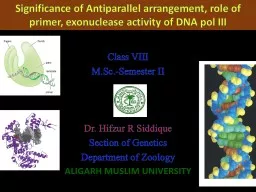

Dr Hifzur R Siddique Section of Genetics Department of Zoology ALIGARH MUSLIM UNIVERSITY Significance of Antiparallel arrangement role of primer exonuclease activity of DNA pol III Exonucleases Proofread Newly Synthesized DNA ID: 920610
Download Presentation The PPT/PDF document "Class X M.Sc.-Semester II" is the property of its rightful owner. Permission is granted to download and print the materials on this web site for personal, non-commercial use only, and to display it on your personal computer provided you do not modify the materials and that you retain all copyright notices contained in the materials. By downloading content from our website, you accept the terms of this agreement.
Slide1
Class XM.Sc.-Semester IIDr. Hifzur R SiddiqueSection of GeneticsDepartment of ZoologyALIGARH MUSLIM UNIVERSITY
Significance of Antiparallel arrangement, role of primer, exonuclease activity of DNA pol III
Slide2Exonucleases Proofread Newly Synthesized DNAA system based only on base-pair geometry and the complementarity between the bases cannot reach the extraordinarily high levels of accuracy.Approximately one mistake in every 1010 bp added. Occasional about one in 105 times) flickering of the bases into the “WRONG” tautomeric form imino or enol.
Slide3Removal of these incorrectly base-paired nucleotides is mediated by a type of nuclease that was originally identified in the same polypeptide as the DNA polymerase. Referred to as proofreading exonuclease, these enzymes degrade DNA starting from a 3` DNA end (i.e., from the growing end).Nucleases that can only degrade from a DNA end are called EXONUCLEASES. Nucleases that can cut within a DNA strand are called ENDONUCLEASES.
Slide4This “proofreading” of the newly added DNA gives the DNA polymerase a second chance to add the correct nucleotide.Proofreading exonucleases work like a “DELETE KEY,” removing only the most recent errors. Proofreading greatly increases the accuracy of DNA synthesis. On average, DNA pol inserts one incorrect nucleotide for every 105 nucleotides added.Proofreading exonucleases decrease the appearance of incorrect base pairs to 1 in every 107 nucleotides added.
Slide5Both Strands of DNA Are Synthesized Together at the Replication ForkBoth strands of the DNA duplex are replicated at the same time.The junction between the newly separated template strands and the un-replicated duplex DNA is known as the replication fork.The resulting short fragments of new DNA formed on the lagging strand are called Okazaki fragments and vary in length from 1000 to 2000 nucleotides in bacteria and from 100 to 400 nucleotides in eukaryotes.
Slide6The Initiation of a New Strand of DNA Requires an RNA PrimerAll DNA polymerases require a primer with a free 3`-OH. They cannot initiate a new DNA strand de novo. Primase is a specialized RNA polymerase dedicated to making short RNA primers (5-10 nucleotides long) on an ssDNA template.Primases prefer to initiate RNA synthesis using an ssDNA template containing a particular trimer GTA.Analysis of the E. coli genome sequence shows that the GTA target sequence for E. coli primase is overrepresented in the portions of the genome that will be the template for lagging strand DNA synthesis.Primase activity is dramatically increased when it associates with another protein that acts at the replication fork called DNA helicase
Slide7RNA Primers Must Be Removed to Complete DNA ReplicationRNaseH recognizes and removes most of each RNA primer. This enzyme specifically degrades RNA that is base-paired with DNA (H= “hybrid” in RNA:DNA hybrid).RNase H removes all of the RNA primer except the ribonucleotide directly linked to the DNA end. This is because RNaseH can only cleave bonds between two ribonucleotides. The final ribonucleotide is removed by a 5` exonuclease that degrades RNA or DNA from their 5` ends. DNA ligases use high-energy
co-factors (such as ATP) to create a phosphodiester bond between an adjacent 5’-phosphate and 3’-OH.
Slide8DNA Helicases Unwind the Double Helix in Advance of the Replication ForkDNA helicases that act at replication forks are hexameric proteins that assume the shape of a ring.When ATP is added to a DNA helicase bound to ssDNA, the helicase moves with a defined polarity on the ssDNA. In the instance illustrated, the DNA helicase has a 5` -3` polarity. This polarity means that the DNA helicase would be bound to the lagging-strand template at the replication fork.
Each DNA helicase moves along ssDNA in a defined direction. This property is referred to as the polarity of the DNA helicase. DNA helicases can have a polarity of either 5`-3` or 3`-5`.
Slide9Single-Stranded DNA-Binding Proteins Stabilize ssDNA before ReplicationCooperative binding ensures that ssDNA is rapidly coated by SSB as it emerges from the DNA helicase.SSBs interact with ssDNA in a sequence-independent manner. ssDNA-binding proteins (SSBs) primarily contact ssDNA through electrostatic interactions with the phosphate backbone and stacking interactions with the DNA bases.
Slide10Topoisomerases Remove Supercoils Produced by DNA Unwinding at the Replication ForkPositive supercoils accumulate in front of the replication fork, topoisomerases rapidly remove them. By passing one part of the un-replicated dsDNA through a double-stranded break in a nearby un-replicated region, the positive supercoils can be removed.It is worth noting that this change would reduce the linking number by two and thus would only have to occur once every 20 bp replicated. Topoisomerases-I can also remove the positive supercoils generated by a replication fork.
Slide11Slide12DNA Polymerases Are Specialized for Different Roles in the Cell613
Slide13DNA Pols in DrosophilaPh.D. Thesis: Hifzur R Siddique
Slide14POLYMERASE SWITCHINGBecause of its relatively low processivity, DNA Pol a/primase is rapidly replaced by the highly processive DNA Pol d and Pol e. The process of replacing DNA Pol a/primase with DNA Pol d and Pol e
is called polymerase switching
Slide15THANK YOU